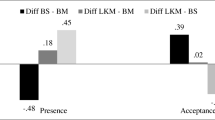Abstract
We investigated whether three different meditation practices that are commonly used in mindfulness-based interventions lead to differential changes in psychological health outcomes when presented separately. Participants included 141 undergraduates assigned to a sitting meditation, body scan, or mindful yoga condition. Participants in all conditions attended three weekly 1-h sessions (105 min of guided meditation and 75 min of discussion) in addition to pre- and post-intervention questionnaires collected in separate sessions. Participants reported significant improvements in the tendency to describe one’s experience, rumination, self-compassion, and psychological well-being regardless of condition. The following between-group differences in change over time emerged: (1) mindful yoga was associated with greater increases in psychological well-being than the other two practices, (2) sitting meditation and mindful yoga were both associated with greater decreases in difficulties with emotion regulation than the body scan, and (3) sitting meditation was associated with greater increases in the tendency to take a nonevaluative stance toward observed stimuli than the body scan.
Similar content being viewed by others
References
Astin, J. (1997). Stress reduction through mindfulness meditation: effects on psychological symptomatology, sense of control, and spiritual experiences. Psychotherapy and Psychosomatics, 66, 97–106. doi:10.1159/000289116.
Baer, R. A. (2003). Mindfulness training as a clinical intervention: a conceptual and empirical review. Clinical Psychology: Science and Practice, 10, 125–143. doi:10.1093/clipsy.bpg015.
Baer, R. A., Smith, G. T., Hopkins, J., Krietemeyer, J., & Toney, L. (2006). Using self-report assessment methods to explore facets of mindfulness. Assessment, 13, 27–45. doi:10.1177/1073191105283504.
Caldwell, K., Emery, L., Harrison, M., & Greeson, J. (2011). Changes in mindfulness, well-being, and sleep quality in college students through Taijiquan course: a cohort control study. Journal of Alternative and Complementary Medicine, 17, 931–938. doi:10.1089/acm.2010.0645.
Carmody, J., & Baer, R. A. (2008). Relationships between mindfulness practice and levels of mindfulness, medical and psychological symptoms and well-being in a mindfulness-based stress reduction program. Journal of Behavioral Medicine, 31, 23–33. doi:10.1007/s10865-007-9130-7.
Carmody, J., Baer, R., Lykins, E., & Olendzki, N. (2009). An empirical study of the mechanisms of mindfulness in a mindfulness-based stress reduction program. Journal of Clinical Psychology, 65, 613–626. doi:10.1002/jclp. 20579.
Chiesa, A., & Serretti, A. (2011). Mindfulness based cognitive therapy for psychiatric disorders: A systematic review and meta analysis. Psychiatry Research, 187, 441–453.
Gratz, K. L., & Roemer, L. (2004). Multidimensional assessment of emotion regulation and dysregulation: development, factor structure, and initial validation of the Difficulties in Emotion Regulation Scale. Journal of Psychopathology and Behavioral Assessment, 26, 41–54. doi:10.1023/B:JOBA.0000007455.08539.94.
Greeson, J. M., Webber, D. M., Smoski, M. J., Brantley, J. G., Ekblad, A. G., Suarez, E. C., & Wolever, R. Q. (2011). Changes in spirituality partly explain health-related quality of life outcomes after mindfulness-based stress reduction. Journal of Behavioral Medicine, 34, 508–518. doi:10.1007/s10865-011-9332-x.
Jacobson, N., Dobson, K., & Truax, P. (1996). A component analysis of cognitive-behavioral treatment for depression. Journal of Clinical and Consulting Psychology, 64, 295–304. doi:10.1037//0022-006X.64.2.295.
Jain, S., Shapiro, S., Swanick, S., Roesch, S., Mills, P., Bell, I., & Schwartz, G. (2007). A randomized controlled trial of mindfulness meditation versus relaxation training: effects on distress, positive states of mind, rumination, and distraction. Annals of Behavioral Medicine, 33, 11–21. doi:10.1207/s15324796abm3301_2.
Kabat-Zinn, J. (1982). An outpatient program in behavioral medicine for chronic pain patients based on the practice of mindfulness meditation: theoretical considerations and preliminary results. General Hospital Psychiatry, 4, 33–47. doi:10.1016/0163-8343(82)90026-3.
Kabat-Zinn, J. (1990). Full catastrophe living: Using the wisdom of your body and mind to face stress, pain and illness. New York: Delacorte.
Keng, S. L., Smoski, M., & Robins, C. (2011). Effects of mindfulness of psychological health: A review of empirical studies. Clinical Psychology Review, 31, 1041–1056. doi:10.1016/j.cpr.2011.04.006.
Little, R. J. A. (1988). A test of missing completely at random for multivariate data for multivariate data with missing values. Journal of the American Statistical Association, 83(404), 1198–1202. doi:10.2307/2290157.
Lovibond, P. F., & Lovibond, S. H. (1995). The structure of negative emotional states: comparison of the Depression Anxiety Stress Scales (DASS) with the Beck Depression and Anxiety Inventories. Behaviour Research and Therapy, 33, 335–343. doi:10.1016/0005-7967(94)00075-U.
Neff, K. D. (2003). The development and validation of a scale to measure self-compassion. Self and Identity, 2, 223–250. doi:10.1080/15298860309027.
Ryff, C. (1989). Happiness is everything, or is it? Explorations on the meaning of psychological well-being. Journal of Personality and Social Psychology, 57, 1069–1081. doi:10.1037/0022-3514.57.6.1069.
Segal, Z., Williams, J., & Teasdale, J. (2002). Mindfulness-based cognitive therapy for depression: A new approach to preventing relapse. New York, NY: Guilford.
Shapiro, S., & Carlson, L. (2009). The art and science of mindfulness: Integrating mindfulness into psychology and the helping professions. Washington DC: American Psychological Association.
Shapiro, S., Schwartz, G., & Bonner, G. (1998). Effects of mindfulness-based stress reduction on medical and premedical students. Journal of Behavioral Medicine, 21, 581–599. doi:10.1023/A:1018700829825.
Shek, D. T. L., & Ma, C. M. S. (2011). Longitudinal data analysis using linear mixed models in SPSS: concepts, procedures, and illustrations. The Scientific World Journal, 11, 42–76.
Trapnell, P. D., & Campbell, J. D. (1999). Private self-consciousness and the five-factor model of personality: distinguishing rumination from reflection. Journal of Personality and Social Psychology, 76, 284–304. doi:10.1037/0022-3514.76.2.284.
Walsh, R. (2011). Lifestyle and mental health. American Psychologist, 66, 579–592. doi:10.1037/a0021769.
Author information
Authors and Affiliations
Corresponding author
Rights and permissions
About this article
Cite this article
Sauer-Zavala, S.E., Walsh, E.C., Eisenlohr-Moul, T.A. et al. Comparing Mindfulness-Based Intervention Strategies: Differential Effects of Sitting Meditation, Body Scan, and Mindful Yoga. Mindfulness 4, 383–388 (2013). https://doi.org/10.1007/s12671-012-0139-9
Published:
Issue Date:
DOI: https://doi.org/10.1007/s12671-012-0139-9




